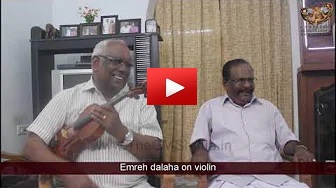
AP 180 to 171
"Lessons:" secular music in sacred space during the Syriac era.
| Call Number | AP 179 |
| Part Number | Part I - Syro Malabar Church |
| Title | "Lessons:" secular music in sacred space during the Syriac era. |
| Duration | 29:46 |
| Place of Recording | Athirampuzha,Kottayam |
| Date of Recording | 31 July,2018 |
| Youtube URL | https://www.youtube.com/watch?v=uuosFHOsqTw |
| Video Segment (s) |
|
Notes
"Lessons:" secular music in sacred space during the Syriac era
Instrumental music during solemn Qurbana in Syriac in the Syro Malabar Church.
This video contains a collection of incidental music that used to be part of the solemn celebration of Syriac Qurbana. The respective instrumentalists performed these melodies as an introduction before the starting of Qurbana, during Communion, or wherever there were a few silent moments to fill in. The musicians referred to these melodies as “Lessons,” and the act of performing the melodies as “lissan kottuka” (Malayalam for playing to “Listen” or playing the lesson). It used to be an occasion to showcase the musicianship of the performer. The musicians used to consider the melodies to be their private property. They would teach them only to selected disciples. Often, performers received recognition based on the number and variety of melodies they knew and the expertise with which they performed them. The melodies were adaptations of practice lessons from the western music tradition, or even South Indian classical music compositions. In other words, the melodies were strictly secular and had no stylistic affinity to the sacred Syriac music repertoire. They were the result of the meeting of many cultures. Thus, this was an area where the sacred and the secular realms met inside the church during the liturgy. People did not seem to resist the permeability of those boundaries. Instead, we have reasons to believe that these performances received appreciation and acknowledgment from the worshippers. Each melody has a history of its own. For that reason, these incidental melodies deserve the attention of musicologists. We have been able to collect only a small number of melodies. Yet, they can be useful for cultural historians for an extensive amount of researches on the movement of music and the formation of cultural sensitivities.
Joseph J. Palackal, CMI
New York
25 March 2020
Related Videos
- AP 4 - Awūn d'waśmayyā [Our Father in heaven]-Track 01- from Qambel Maran: Syriac Chants from South India
- AP 4a - Hallel hallel [Praise, praise] -Track 02
- AP 4b - Iśo māran m'śihā [Lord Jesus Christ] -Track 03
- AP 4c - Mārya kolhōn hāwbai [Lord, all my faults]-Track 04
- AP 4d - B'endān saprā [In the morning] Track 05
- AP 4e - Esthappānōs [St. Stephen] Track 06
- AP 4f - Brīk hannānā¯ [Blessed is the merciful one] - Track 07
- AP 4g - Etpan al slōţā [Turn to the prayer] Track 08
- AP 4h - Tāw n'yaqar [Come, let us honor] Track 09
- AP 4i - Slīwā dahwā lan [The Cross that became for us] Track 10
- AP 4j - O dezdamman īnja [O you who are invited] Track 11
- AP 4k - K'ţāwā rambā [The great book] Track 12
- AP 4l - "Ślām lēk maryam [Hail Mary] Track 13
- AP 4n - Lā tekre lāk [Do not be sorry] Track 16
- AP 4o - B'had min yawmīn [On one of the days] Track 17
- AP 4q - Quryēlaisōn [Lord, have mercy] Track 19-
- AP 4r - Hā qes slīwā [Behold the wood of the Cross] Track 20
- AP 4s - Śanbah leśān [Praise, my tongue] Track 21
- AP 4t - Kollan daśnē [Let us all offer; Syriac of `Pange lingua' by St. Thomas Aquinas] Track 22
- AP 4u - Tā lāk ruhā [Come O Spirit] Track 23
- AP 4v - Ślām lēk [Hail to you Mary] Track 24
- AP 4w - Bar maryam [Son of Mary] Track 25
- AP 4x - Lak mar yawsep.- Track 26.
- AP 4y - "Sabbah l'marya." Track 27
- AP 4z - "Hadmin ire." Track 28
- AP 4aa - "B'eda d'yawman." Track 29
- AP 119 - Solemn Syriac Qurbana . Fr. Probus Perumalil, CMI. A musical treasure.
- AP 119a - A different way of singing Qandisa Alaha (pre 1962 Missal). Fr. Perumalil CMI.
- AP 126 - Syriac chants from the Benediction. Fr. Probus Perumalil, CMI.
- AP 252a - A different way of singing Qandisa Alaha (pre 1962 Missal). Fr. Perumalil CMI. *************
- AP 39 - Melody of " Ennaana lahma" (I am the Bread). Marth Mariyam Church Kuravilangad
- AP 78a - Melody of ""Ennan lahma" I am the living bread
- AP 78H - സുറിയാനി സംഗീതം ആദ്യം കയ്ക്കും പിന്നെ മധുരിക്കും : Binu & Deepa Mathirampuzha.
- AP 70AF - Ennānā Lahmā I Am The Living Bread Fr George Plathottam
- AP 90 - Young Syro Malabar Catholics getting comfortable with bilingual Qurbana
- AP 96 - Solemn Sung Qurbana in Syriac at Iringalakkuda
- AP 100 - A Historic Event - Solemn Qurbana in Syriac in the USA
- AP 127 - Syriac chants during the Nuptial Qurbana for Abu Alex and Stephy Joy
- AP 139 - Pappootty Master and Bennedy Anikkad: rare melodies and memories - Part II
- AP 155 - Bishop Joseph Kallarangatt. Solemn Qurbana in Syriac. Elanji
- AP 165-33 - "Ennanaa." "I am the living bread." Fr. Saji Mattathil
- AP 201 - Bishop Mar Thomas Tharayil: Syriac Hymns and Kyananas during Bilingual Qurbana
- AP 288 - Rare melodies from the Syro Malabar Requiem Qurbana in Syriac.

